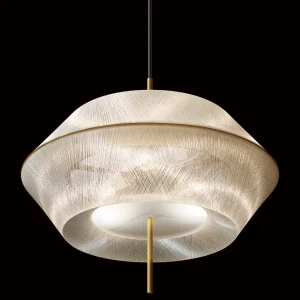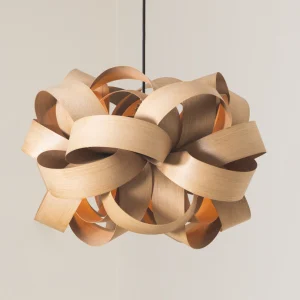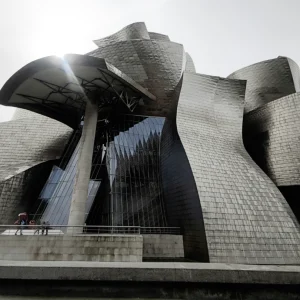Words By Pamela Buxton
1. For us, the story is always the starting point
During the 1990s, we gravitated to mostly designing narrative-led projects after starting out in commercial interior design. Our first exhibition project was British Design New Traditions at the Boijmans Van Beuningen museum in Rotterdam, with Malcolm Garrett doing the graphics. We had so much fun doing it, and began to realise that the lens of telling a story focuses the mind by providing the rationale to rigorously assess every design decision we make. And that began to excite us – with a lot of other interiors it’s more about style and taste for the sake of it rather than for storytelling. With museums, you’re still designing meticulously detailed and beautiful spaces, but with the added challenge and complexity of creating an engaging experience that enables visitors to understand the story.
Fortuitously for us, just as we were exploring getting into exhibition design, the National Lottery and Heritage Lottery Fund started pouring money into cultural projects in the mid 1990s, and there was a noticeable uplift in opportunities. We broke into the sector just as it became more buoyant, and haven’t looked back.

2. Immersive spaces encourage visitors to engage by stimulating a heightened spatial and sensory awareness so that they are more receptive to the story you’re trying to tell.
In terms of immersion, we’ve learnt to use not just digital media but everything at our disposal to help people engage with the stories. It’s important that every aspect of the environment contributes to telling the story, and we’re always looking for new ways to maximise those possibilities.
Exhibition design used to be only about the object, cabinet and text panel, but over time, more and more layers have been added into the mix. Now we have all these other tools to play with, and the palette has got bigger. Everything has to be orchestrated in a holistic way: materiality, form, space, light, colour, sound, smell, media, movement. But the biggest challenge is doing everything all at once – and a lot of museums are too frenetic and cacophonous. You mustn’t lose sight of the need to create somewhere beautiful and elegant that people will enjoy being in, if you want them to engage with the story.
 Casson Mann’s visitor attraction at the World Heritage Site of Lascaux, features a state-of-the-art facsimile of the Paleolithic painted cave. Image Credit: Boegly + Grazia
Casson Mann’s visitor attraction at the World Heritage Site of Lascaux, features a state-of-the-art facsimile of the Paleolithic painted cave. Image Credit: Boegly + Grazia
3. Most museum visitors do not want to read large amounts of text
Apparently, on average only 17% of the available text in museums is read. I really don’t like what we call the ‘book on the wall’ splurge of text that ends up wallpapering quite a lot of the surface area on exhibition walls, and sometimes gets mixed in with images. It’s just too much – you can’t read it all. We prefer giving visitors the option to read more if they want to – whether via a screen or through the way the text is arranged, as we first did at the British Galleries at the V&A back in 2001. That’s a lot easier, and less exhausting, for visitors.
4. Objects, particularly those that are witness to amazing events, have extraordinary auras
We noticed in our work at the V&A how people engage easily with beautiful objects – there’s a simple appeal. But often it’s what we call the ‘ugly brown things’ that don’t look anything special, but have amazing stories, that potentially have the most powerful auras. However, they usually need help with communicating their story.
Through our projects at the Science Museum and Imperial War Museum (IWM) London we’ve often told stories that aren’t about the aesthetic, and we’ve become interested in how we could use media to help that object speak louder and share its story. Carefully judged and with sensitivity and a sharp focus on authenticity, digital media can be the magic that powerfully ‘unlocks’ the aura, which then suddenly becomes very, very apparent.
 More than 1,600 large and small objects are on display at the First World War Galleries at London’s Imperial War Museum. Image Credit: Casson Mann
More than 1,600 large and small objects are on display at the First World War Galleries at London’s Imperial War Museum. Image Credit: Casson Mann
5. Digital media is both a blessing and a curse
Done well, it’s fabulous and helps tell stories – a magical dialogue between the tangible and the intangible. Done badly it can be an insensitive and inappropriately styled clash that swamps the object. We’re always trying to do interesting things with media – but you have to be very demanding of it and very critical of what it’s doing.
We’ve been exploring the proximity of media to object, and how to bring them together, for some years now. It’s quite hard to make it work and I see the potential for all sorts of pitfalls – there can be a jarring clash of modernity and history in which the ‘fragile’ aura of the object is struggling. But it’s exciting when it works. We feel it worked well in the reflection spaces in the First World War Galleries at the IWM London. Here, there’s a small leather glove under a glass cloche, a man’s glove that shrunk from the effects of a gas attack and and as such is a witness to the impact of gas in warfare. We put it in the middle of a round table, and on that are contemporaneous words from letters home and newspaper articles playing out around the object, talking about the ethics of war and in particular the use of gas. It carefully underpins and makes manifest the glove’s aura.
 For the Musée National de la Marine in Paris, a key objective was to attract new audiences, especially young people. Image Credit: Boegly + Grazia
For the Musée National de la Marine in Paris, a key objective was to attract new audiences, especially young people. Image Credit: Boegly + Grazia
6. Collaboration is a massive part of what we do
Collaboration with exceptional people is essential for the quality of the result. The complexity of what we do means that we need to create bespoke teams for each project, and often these can very big, 30-plus people: lighting designers, graphics, multimedia, interactive, sound, engineers… project managers, cost managers, artists, play writers, perfumers, and even, for Lascaux, the team included French prehistorians – the list is long.
Managing this collaboration is a constant learning curve. It’s our job to have the overall vision, and to creatively direct these large teams in order to nurture and orchestrate the shared endeavour. We really welcome all their inputs, insight and, importantly, challenges – the rigorous, collaborative testing of ideas. It’s a lot of work, but a lot of fun.
7. The use of a traditional, authoritative ‘museum’ voice is changing
Instead, there are shifting perspectives as museums strive to establish the right voice, one that feels more welcoming, inclusive and ultimately engaging. As designers, we need to think carefully about how to frame things to convey these other perspectives.
We’re seeing this in our Oceania project at the Ubersee-Museum in Bremen. This is being told from the point of view of Pacific islanders, rather than an anonymous museum voice, so that visitors feel connected with a collective view that captures various perspectives. Objects are being chosen and curated with Pacific communities and their stories are communicated through a voice that is conversational, multi-vocal and immediate
At our Showtown project in Blackpool (which opened in March) we employed comedy writer Jayne Kirkham to develop a fresh tone that is playful and informal, and uses verse, riddles and jokes to tell the story.
8. Listening covers so many different aspects of what we do
Exhibition design is a fantastic profession because of the access we have to a wealth of extraordinary people – the most amazing astronomers, surgeons, historians, artists etc. – and we always enjoy talking to them. We learn from all these experts and get excited about the subject, and that’s the most incredible starting point. Now we’re also listening more to our audiences.
We’ve always asked ourselves who’s going to come, what do visitors really want to know, and what will excite and inspire them. Making the museums and exhibitions we design more accessible to more people, with many different needs and desires, is absolutely expected by audiences now, and is a constant challenge. We are learning to listen to all sorts of people, from clients full of their knowledge to communities who might like to go to a museum but don’t think it’s for them. We’re giving visitors a range of routes into the content and offering something for everyone. We’re embedding a multiplicity of voices and co-curated content, and we’re using multisensory experiences to widen accessibility.
For the Musée National de la Marine in Paris, for example, a key objective was to attract new audiences to the museum, especially young people, and the museum also wanted to achieve a gold standard for accessibility. Our design includes many imaginative ways to engage visitors: tactile models, interactives that allow you to create or design, places to sit and rest and reflect. We participated in workshops with both able-bodied and disabled visitors to test our concepts.
‘Universal access’ is now the buzzword and has become a major part of what we’re doing. For Showtown, we responded to feedback from over 19,000 consultees with the aim of creating something that the local community can feel ownership of. It all boils down to listening, and understanding, and letting what we learn from this affect what we do. It makes it more complex as a process, but we end up with better stories, and a much richer result.
9. Mix things up
We’re constantly looking for ways to stir the pot by not being too guarded, precious or purist, but by instead relinquishing some control and allowing surprising, unexpected things into the creative process. Netia Jones with her experience in theatre helped us shape the vision for Ocean Liners at the V&A, which included the Grande Descente, a sumptuous evocation of the grand staircase, featuring actors dressed for dinner filmed using time-lapse and layering techniques. For Showtown, we assembled a ‘clowncil’ of comedians, funny people who became a kind of creative catalyst for us – helping us to consider key questions like ‘what is funny?’ in a fresh way.
We like being playful. Playful thinking is key to our working process – making models, playing around with ideas. One of the joys of bringing in collaborators is the chance of that happening. We enjoy forming new creative relationships that can help inject new thinking into a project.
10. Surround yourself with very capable and creative people
If I’ve learnt one thing in 40 years it’s this, because that’s what it’s been like working at Casson Mann. It’s a massive communal exercise. The people who gravitate towards working for us really want to tell stories, and some have been here over 20 years.
Looking back… the no-plan that was Casson Mann has been such enormous fun that I don’t really have many regrets. I love the excitement of the origination of an idea. I really enjoy the process – the endless challenge of getting to fruition all the ideas you had in the first place. And I also love the thrill of it opening.
Our reward is the satisfaction of seeing the design enjoyed by the public and the feedback, not just the press feedback, but when you get the real feedback on social media. When you hear that all the layers and complexity have hit the mark with the public you’re designed it for, it’s fantastic.





